Why Use AAC for Toddlers or Children?
AAC devices are augmentative/alternative communication systems that allow a person to communicate with those around them without speaking. There are many different types of AAC but the most common are high-tech AAC Devices that allow a person to push a button to speak a message. These are helpful for children or adults who have either lost the ability to speak or who are not able to speak well enough to clearly communicate everything that they want to say.
So why would you need to use AAC with a toddler or child and how does it work?
Why to Use AAC Podcast:
Today we’re talking about how, when, and why to use AAC or augmentative-alternative communication devices and systems. AAC allows children who are not able to talk to use something else to communicate with those around them. Every child has the right to communication and it is our job as speech-language pathologists to figure out a way for every child to do just that.
This podcast will go over the basics of what is AAC, how to use it to help a child communicate, when it is appropriate to use AAC, and why it should be considered as an option for non-verbal and minimally-verbal children. Click the play button below to hear the whole podcast, or scroll down to read the quick notes:
Show Notes:
What is Augmentative/Alternative Communication (AAC)?
AAC is the term used to describe any form of communication that a person can use that is not speech. This may include pointing to pictures of what the person wants, using sign language, or using a device that will speak a message when a specific button is pushed.
When Should AAC be Considered for a Child?
AAC should be considered for any child when his/her speech output is not adequate to communicate everything that the child wants/needs to communicate.
Things to consider:
- Child’s frustration levels
- Adult frustration levels
- Access to school curriculum
- Participation in classroom activities
- Ability to demonstrate knowledge to teachers
- Access to home and community environment
- Ability to interact appropriately with family and peers
- Independence in developmentally-appropriate daily activities
What Prerequisite Skills Does a Child Need Before Trying AAC?
In short, there are no skills that a child MUST have before AAC can be tried. Though, here are a few of the common misconceptions about this:
These are commonly used as excuses why AAC devices should not be attempted with children but these are WRONG:
- The child must understand cause and effect (AAC teaches cause and effect quite effectively)
- The child must understand that a picture represents an object (again, AAC teaches this)
- Child must have good enough motor skills for AAC (there are lots of alternatives for children who can’t access a device with their hands)
- Child must understand enough language for AAC use (babies don’t have great language before they are introduced to speech)
- Child must be interested in communicating (even inappropriate behaviors can be shaped into intentional communication)
For more information about these “prerequisites”, click the link: http://www.speechandlanguagekids.com/what-are-the-prerequisites-for-using-an-aac-device-augmentativealternative-communication/
Options for AAC devices, methods, and systems
- Gestures/Body Language
- Sign Language
- Object Symbols (objects glued to cards)
- Picture Boards
- Picture Exchange
- Written Messages (paper or typed)
- Single Button Voice-Output Devices
- Multi-Button Voice-Output Devices
- Dynamic-Display Voice-Output Devices
Download the free PDF cheat sheet of the different types of AAC here:
How to Introduce the System:
Make it as natural as possible. Think of it as similar to how you would encourage a late talker to talk.
- Get Familiar with the Child’s System
- Model AAC Use Around the Child
- Encourage the Child When he Attempts to Use it and Provide Differential Reinforcement
- Have the Device Present at All Times
- Set Up Opportunities for the Child to Use the AAC Device (in the classroom, at home, in speech, etc.)
- Train Other Adults on How to Set Up Opportunities and Provide Differential Reinforcement
For more info on getting started, click the link: http://www.speechandlanguagekids.com/help-child-use-aac-home-classroom-hint-easier-think/

About the Author: Carrie Clark, MA CCC-SLP
Hi, I’m Carrie! I’m a speech-language pathologist from Columbia, Missouri, USA. I’ve worked with children and teenagers of all ages in schools, preschools, and even my own private practice. I love digging through the research on speech and language topics and breaking it down into step-by-step plans for my followers.
Connect with Me:
Podcast: Play in new window | Download | Embed
Subscribe: Apple Podcasts | RSS
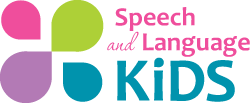
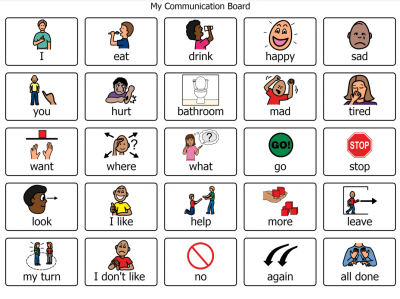
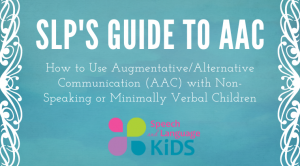
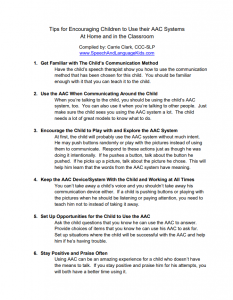
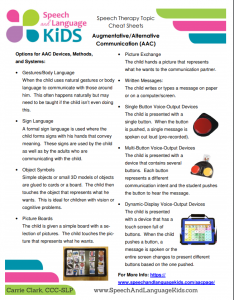
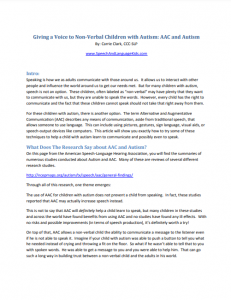


This was a very informative presentation. I provide advocacy support to families raising children with disabilities and/or special health care needs. I frequently attend Planning and Placement Team meetings. I attempt to assist parents to ensure that their child’s IEP Goals and Objectives are appropriate. Communication is so important! I have heard many of the “misconceptions,” you outlined in this podcast, from school personnel. I’ve downloaded the “cheat sheet,” for future reference. I am really enjoying your web site and receiving your free emails. Many thanks!
That’s great! I’m so glad this is helpful!
I tried the speechandlanguagekids.com/episode64 for additional notes but that website isn’t working. I keep getting 404 for that website. Are you able to email the notes to me?
Sorry about that, you found the correct post though. These are the notes for that podcast episode.
Can I use this for a 19 month old with expressive and receptive language delays? He’s completely nonverbal and doesn’t use body language either. He just gets so frustrated when he wants/needs something and I can’t figure out what it is.
love how you highlighted the importance of communication for all kids!